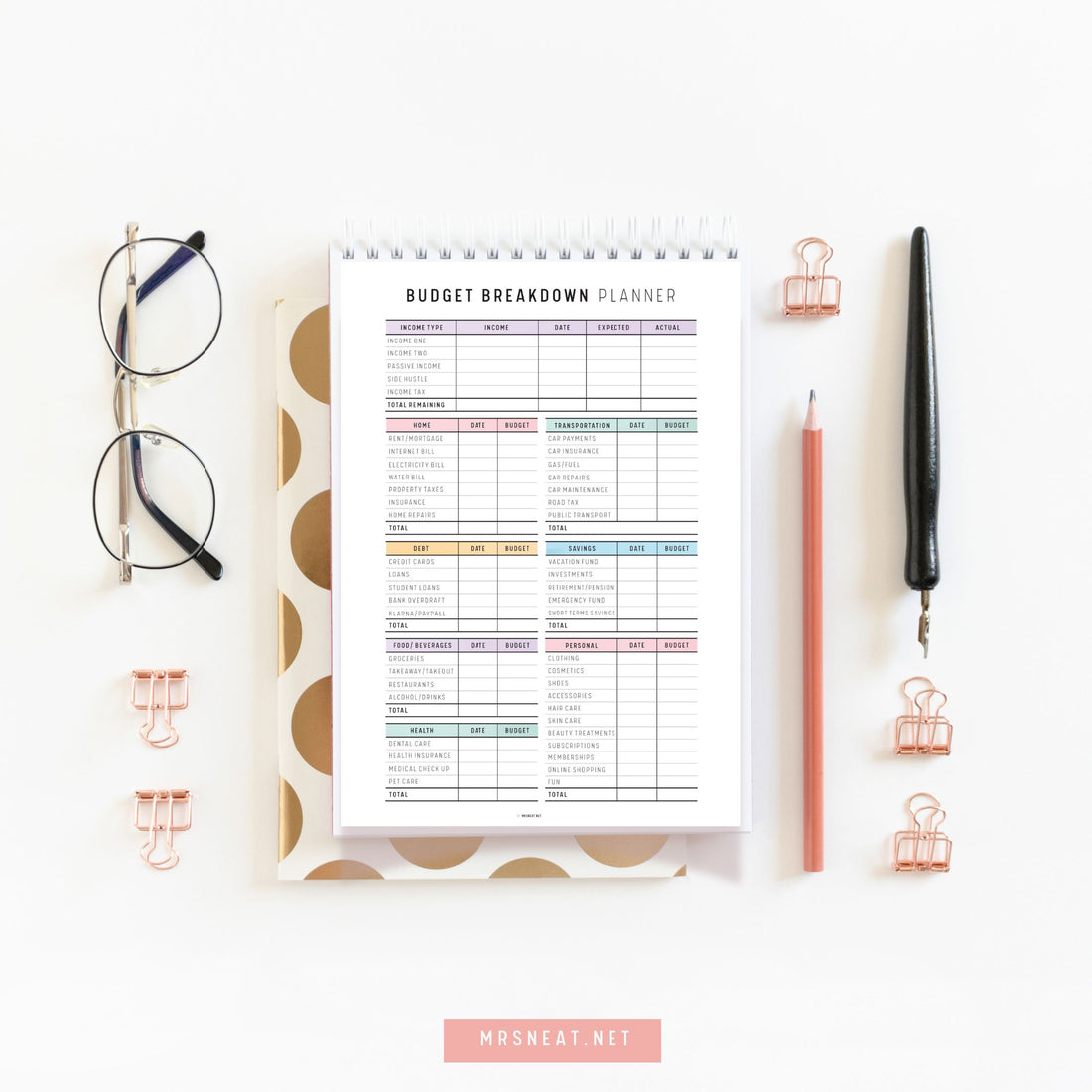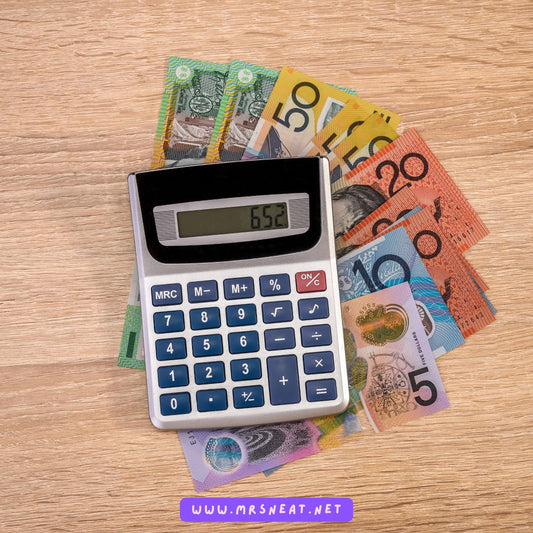
Digital vs. Paper: Which Budget Planner is Right for You?
maris wariShare
Budgeting is a cornerstone of financial health, helping individuals track their income, control their spending, and plan for future expenses.
A well-structured budget can make the difference between financial stability and monetary chaos. Whether you're saving for a significant purchase, paying down debt, or simply trying to live within your means, budgeting is essential.
When it comes to budgeting, one critical decision is choosing the right tool to manage your finances. Should you go digital or stick with traditional paper budget planners?
Each method has its unique advantages and drawbacks, catering to different preferences and lifestyles.
In this blog post, we will explore the following points to help you decide which budget planner is right for you:
Ease of Use and Accessibility: We'll compare the convenience and accessibility of digital budget planners with their paper counterparts, considering factors such as portability and ease of updates.
Features and Customization: We'll look at the different features each option offers, from automatic calculations and syncing capabilities in digital planners to the personalized touch and flexibility of paper planners.
Cost Considerations: We'll examine the costs associated with both types of planners, including initial investments and any ongoing expenses.
Environmental Impact: We'll discuss the environmental implications of both digital and paper planners, helping you make a choice that aligns with your eco-friendly values.
Personal Preferences and Habits: We'll consider how individual preferences and habits can influence the effectiveness of your budgeting, whether you prefer the tactile experience of writing or the seamless integration of technology.
By the end of this post, you'll have a clearer understanding of the pros and cons of digital and paper budget planners, helping you make an informed decision that suits your financial management style and goals.
Overview of Budget Planners
Definition and Purpose of Budget Planners
Budget planners are tools designed to help individuals and households manage their finances by tracking income, expenses, savings, and investments.
They serve as a blueprint for financial planning, allowing users to set financial goals, monitor their spending habits, and make informed decisions about their money.
A budget planner can come in various forms, from simple spreadsheets and notebooks to sophisticated software and mobile apps.
The primary purpose of a budget planner is to provide a clear and organized overview of one's financial situation, promoting better money management and helping to achieve financial objectives.
Importance of Choosing the Right Type for Individual Needs
Selecting the right type of budget planner is crucial because it can significantly impact the effectiveness of your financial management.
The best budget planner for you will align with your lifestyle, preferences, and financial goals.
For instance, a digital budget planner might be ideal for someone who prefers automation, enjoys using technology, and requires access to their budget on-the-go.
Digital tools often come with features like expense tracking, real-time updates, and synchronization across devices, which can streamline the budgeting process.
On the other hand, a paper budget planner might be more suitable for individuals who appreciate the tactile experience of writing things down, prefer to avoid screen time, or enjoy a more personalized approach to budgeting.
Paper planners can be customized to fit specific needs and preferences, providing a tangible connection to one’s financial planning.
Choosing the right type of budget planner ensures that the process of managing finances is not only efficient but also enjoyable and sustainable.
It encourages consistent use and helps develop good financial habits, ultimately leading to better financial health and stability.
Whether you opt for a digital or paper planner, the key is to find a system that you will stick with, one that fits seamlessly into your daily routine and supports your financial goals.
Digital Budget Planners
Advantages of using digital budget planners
Accessibility and Convenience
One of the most significant advantages of digital budget planners is their accessibility and convenience.
These tools can be accessed from multiple devices, including smartphones, tablets, and computers, ensuring that you have your budget information at your fingertips wherever you go.
This multi-device access allows for real-time updates and on-the-go tracking, making it easier to stay on top of your finances without the need for physical materials.
Automated Calculations and Error Reduction
Digital budget planners excel in automating calculations, which significantly reduces the risk of human error.
These tools can automatically sum totals, calculate percentages, and adjust balances as new entries are made.
This automation not only saves time but also ensures greater accuracy in your financial records, providing a more reliable picture of your financial situation.
Customizability
Another key advantage of digital budget planners is their customizability. These tools allow users to easily adjust and update their budgets as needed.
You can quickly modify categories, set different financial goals, and adjust spending limits.
Many digital planners also offer visual aids like charts and graphs, which can be customized to highlight the most critical aspects of your financial health, making it easier to interpret and act on the data.
Integration with Other Financial Tools and Apps
Digital budget planners often integrate seamlessly with other financial tools and apps. For example, they can sync with your bank accounts, credit cards, and investment accounts to provide a comprehensive view of your financial status.
This integration enables automatic importing of transactions, categorization of expenses, and even tracking of investment performance, creating a holistic approach to financial management.
Disadvantages of using digital budget planners
Dependence on Technology and Internet Access
One of the primary drawbacks of digital budget planners is their dependence on technology and internet access.
If you experience technical issues, such as device malfunctions or internet outages, you may temporarily lose access to your budgeting tool.
This dependence can be particularly problematic in situations where immediate access to financial information is critical.
Potential Security and Privacy Concerns
Security and privacy concerns are significant disadvantages of digital budget planners. Storing sensitive financial information online can make you vulnerable to cyberattacks and data breaches.
While many digital budget planners use encryption and other security measures to protect your data, there is always a risk associated with online financial management.
Users must be vigilant about security practices, such as using strong passwords and enabling two-factor authentication.
Learning Curve for New Users
For individuals who are not tech-savvy, there can be a learning curve associated with using digital budget planners.
These tools often come with various features and functionalities that can be overwhelming for new users. It may take some time to become comfortable with the interface and fully utilize all the available features.
This initial learning period can be a barrier to effective budgeting for those who prefer straightforward, uncomplicated methods.
In conclusion, digital budget planners offer numerous advantages, such as accessibility, automation, customizability, and integration with other financial tools.
However, they also come with drawbacks, including dependence on technology, potential security risks, and a learning curve for new users.
Weighing these pros and cons can help you determine if a digital budget planner aligns with your needs and preferences.
Paper Budget Planners
Advantages of using paper budget planners
Tangible and Tactile Experience
One of the most appealing aspects of paper budget planners is the tangible and tactile experience they offer.
Writing things down by hand can make the process of budgeting feel more concrete and personal.
This physical interaction can enhance your connection to your financial plans and goals, making the act of budgeting more engaging and satisfying.
No Need for Batteries or Internet Connection
Paper budget planners do not rely on technology, which means they never need batteries or an internet connection.
This independence from electronic devices ensures that you can access and update your budget anytime and anywhere without worrying about technical issues.
This can be particularly advantageous in areas with unreliable internet access or for individuals who prefer to minimize their screen time.
Easier for Some People to Conceptualize and Visualize Their Finances
For many people, the process of writing by hand and visually organizing information on paper can make it easier to conceptualize and understand their finances.
The act of manually entering numbers and drawing charts can help solidify financial concepts and create a clearer mental picture of income and expenses.
This hands-on approach can be particularly beneficial for visual learners and those who find digital screens overwhelming or distracting.
Personalization Through Handwriting and Decorations
Paper budget planners offer a high degree of personalization through handwriting and decorations.
You can customize your planner with different colors, stickers, and layouts to suit your preferences and style. This creative aspect can make budgeting more enjoyable and motivating, encouraging consistent use and regular updates.
Personalizing your budget planner can also help reinforce your financial goals and priorities in a visually appealing way.
Disadvantages of using paper budget planners
Less Efficient for Complex Calculations
One significant drawback of paper budget planners is their inefficiency in handling complex calculations. Unlike digital tools, which can automatically perform calculations and adjustments, paper planners require manual computation.
This can be time-consuming and increases the risk of errors, particularly for individuals managing intricate budgets with multiple categories and frequent changes.
Risk of Physical Damage or Loss
Paper budget planners are susceptible to physical damage or loss. Spills, tears, and other accidents can ruin your planner, potentially erasing important financial information.
Additionally, losing a paper planner means losing all the data it contains, with no way to recover it unless you have made copies. This vulnerability can be a significant concern, especially for those who rely heavily on their budget planner for financial tracking.
Can Be Cumbersome to Carry and Update Regularly
Carrying and regularly updating a paper budget planner can be cumbersome. Unlike digital planners that fit in your pocket via a smartphone app, paper planners can be bulky and inconvenient to transport.
This physical bulkiness can discourage frequent updates and on-the-go tracking, potentially leading to less accurate and up-to-date financial records.
The manual nature of paper planners also means that keeping them current requires more time and effort compared to digital alternatives.
In conclusion, paper budget planners provide a tangible, customizable, and technology-independent way to manage finances, appealing to those who prefer a hands-on approach.
However, they also come with disadvantages such as inefficiency for complex calculations, vulnerability to physical damage or loss, and the inconvenience of carrying and updating them regularly.
Weighing these pros and cons will help you decide if a paper budget planner is the right fit for your financial management style.
Factors to Consider When Choosing a Budget Planner
Personal Preference and Comfort with Technology
Your comfort level with technology is a crucial factor in choosing between a digital and paper budget planner. If you enjoy using gadgets, apps, and online tools, a digital budget planner might be more suitable for you.
These tools often provide automated features and real-time updates that can streamline the budgeting process.
On the other hand, if you prefer a more hands-on approach and enjoy the tactile experience of writing things down, a paper budget planner might be a better fit.
Assessing your personal preferences will help ensure that you choose a tool you are comfortable with and more likely to use consistently.
Specific Budgeting Needs (Simple vs. Complex Budgets)
Consider the complexity of your budgeting needs when choosing a planner. If your budget is relatively simple, with a few income sources and regular expenses, a paper budget planner might suffice.
However, if you have a more complex financial situation with multiple income streams, investments, debts, and irregular expenses, a digital budget planner might be more efficient.
Digital planners can handle complex calculations and provide detailed analytics that help you track and manage your finances more effectively.
Lifestyle and Accessibility (On-the-Go vs. Home-Based Planning)
Your lifestyle and how you plan to use your budget planner also play a significant role in your decision.
If you are often on the move and need to access your budget information from different locations, a digital budget planner is likely the better choice.
These tools offer the convenience of accessing your data from multiple devices, making it easier to keep your budget up to date wherever you are.
Conversely, if you prefer to do your budgeting at home, in a quiet and distraction-free environment, a paper budget planner can provide a satisfying and focused experience.
Data Security and Privacy Concerns
Data security and privacy are important considerations, especially when dealing with sensitive financial information. Digital budget planners, while offering convenience, come with potential risks of cyberattacks and data breaches.
Ensure that any digital tool you choose has robust security measures, such as encryption and two-factor authentication.
On the other hand, paper budget planners eliminate the risk of cyber threats but can be susceptible to physical loss or damage. Evaluate how much you value data security and choose accordingly.
Integration with Other Financial Management Tools
If you already use other financial management tools, consider how well a budget planner can integrate with them.
Digital budget planners often offer seamless integration with bank accounts, credit cards, and investment platforms, providing a comprehensive view of your financial situation.
This integration can simplify the tracking of transactions and help automate many aspects of budgeting. In contrast, paper budget planners do not offer this kind of connectivity, which might be a disadvantage if you rely heavily on other financial tools for managing your finances.
In summary, choosing the right budget planner depends on a variety of factors, including your personal preference and comfort with technology, the complexity of your budgeting needs, your lifestyle and accessibility requirements, data security and privacy concerns, and the integration capabilities with other financial tools.
By carefully considering these factors, you can select a budget planner that best supports your financial management goals and fits seamlessly into your daily life.
Hybrid Approach to Budget Planning
Combining Digital and Paper Planners for a Balanced Approach
A hybrid approach to budget planning involves using both digital and paper planners to leverage the strengths of each method. This approach provides a comprehensive, flexible, and personalized way to manage your finances.
By combining the automation and accessibility of digital tools with the tactile and customizable nature of paper planners, you can create a robust budgeting system that caters to a wide range of needs and preferences.
This balanced approach allows you to enjoy the benefits of both methods while mitigating their respective disadvantages.
Examples of How to Effectively Use Both Methods Together
To effectively use both digital and paper planners together, you can designate specific tasks for each tool based on their strengths.
For example, you can use a digital budget planner for tracking daily expenses, automated calculations, and real-time updates.
This tool can integrate with your bank accounts and credit cards to provide an accurate and up-to-date overview of your financial status.
On the other hand, you can use a paper planner for broader financial planning tasks such as setting long-term goals, creating monthly budgets, and conducting periodic reviews.
Writing these plans by hand can help you better conceptualize your financial objectives and strategies.
Additionally, you can use the paper planner to jot down notes, reflections, and personalized financial insights that might not fit neatly into a digital format.
Benefits of a Hybrid Approach (Best of Both Worlds)
The hybrid approach offers several benefits by combining the best aspects of both digital and paper budget planners.
Enhanced Accuracy and Efficiency: Digital planners excel at handling calculations and providing real-time updates, ensuring that your financial data is accurate and up-to-date. This reduces the risk of errors and saves time, making day-to-day expense tracking more efficient.
Personalization and Engagement: Paper planners allow for a high degree of personalization through handwriting, decorations, and custom layouts.
This can make budgeting more engaging and enjoyable, encouraging consistent use and deeper reflection on financial goals.
Flexibility and Redundancy: Using both digital and paper planners adds flexibility and redundancy to your budgeting system.
If you encounter technical issues with your digital planner, your paper planner can serve as a backup. Conversely, if your paper planner is misplaced or damaged, your digital planner can provide immediate access to your financial information.
Comprehensive Financial Overview: A hybrid approach enables you to take advantage of the detailed analytics and integration capabilities of digital tools while also benefiting from the broader, more conceptual planning facilitated by paper planners.
This combination can provide a more comprehensive and holistic view of your finances, helping you make more informed decisions.
Improved Accessibility: The hybrid approach ensures that you have access to your budget information in various contexts.
You can use your digital planner when on-the-go or during busy days, and your paper planner during quiet moments at home when you have the time and space to reflect and plan more thoroughly.
In conclusion, a hybrid approach to budget planning offers the best of both digital and paper methods.
By effectively combining the strengths of each, you can create a flexible, accurate, and engaging budgeting system that caters to your individual needs and preferences.
This balanced approach can help you achieve better financial health and stability, leveraging the unique advantages of both digital and paper tools.
Conclusion
In this blog post, we've explored the importance of budgeting for financial health and the key differences between digital and paper budget planners.
We discussed the advantages and disadvantages of each method, such as the accessibility and automation of digital planners and the tactile, personalized experience of paper planners.
We also highlighted a hybrid approach, which combines the strengths of both methods to provide a comprehensive and flexible budgeting system.
Finally, we shared personal experiences and testimonials to illustrate how different tools work for different people.
Choosing the right budget planner ultimately depends on your individual preferences and needs.
If you thrive on convenience, real-time updates, and integration with other financial tools, a digital planner may be the best choice for you.
If you prefer a more hands-on, personalized approach that allows for creative expression, a paper planner might be more suitable. For those who want the benefits of both, a hybrid approach can offer the perfect balance.
We encourage you to experiment with both digital and paper budget planners to find what works best for you.
Try different tools and methods to see which one aligns with your lifestyle, financial goals, and personal preferences.
Remember, the most important aspect of budgeting is consistency and finding a system that you will stick with over the long term.
We invite you to share your experiences and preferences in the comments section below.
Have you tried digital or paper budget planners? What worked for you and what didn’t?
Your insights can help others in the community make informed decisions about their budgeting tools.
Links to Popular Digital Budget Planner Apps and Tools
Printable Paper Budget Planner Templates
- Budget Template by Mrsneat
- Clever Fox Budget Planner
- Free Printable Budget Planner from Savvy Spreadsheets
- Printable Budget Planner by Canva
Further Reading on Budgeting Tips and Financial Planning
- The Total Money Makeover by Dave Ramsey
- Financial Peace Revisited by Dave Ramsey
- Your Money or Your Life by Vicki Robin and Joe Dominguez
- I Will Teach You to Be Rich by Ramit Sethi
By exploring these resources and experimenting with different budgeting methods, you can find the perfect tool to help you achieve your financial goals.
Happy budgeting!
This post contains affiliate links, and I may earn a commission if you make a purchase through these links at no extra cost to you.




 https://www.linkedin.com/in/mariswari/
https://www.linkedin.com/in/mariswari/



